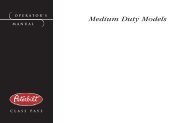MODEL 330 OPERATOR'S MANUAL - Peterbilt Motors Company
MODEL 330 OPERATOR'S MANUAL - Peterbilt Motors Company
MODEL 330 OPERATOR'S MANUAL - Peterbilt Motors Company
Create successful ePaper yourself
Turn your PDF publications into a flip-book with our unique Google optimized e-Paper software.
Operating Instructions<br />
WARNING! Do not wear the shoulder belt under<br />
your arm or otherwise out of position. In a crash<br />
your body would move too far forward, increasing<br />
the chance of head and neck injury. Also, the belt<br />
would apply too much force to the ribs, which are<br />
not as strong as your shoulder bones, and could<br />
cause you to suffer internal injuries. Wear the<br />
shoulder belt over your shoulder (see “Safety<br />
Restraint Belts” on page 44).<br />
WARNING! Do not twist the belt in the process of<br />
putting it on. A twisted belt will not work as well<br />
to protect you. In a crash, the full width of the<br />
belt would not be protecting you. A twisted belt<br />
could cut into your body and cause serious injuries.<br />
Straighten the belt before buckling it. If you<br />
are unable to wear it without twisting it, have<br />
your dealer or service person repair it as soon<br />
as possible.<br />
Safety Restraint Tips<br />
• Anyone riding in your vehicle should wear a seat belt. A<br />
responsible operator sees to it that everyone in the vehicle<br />
rides safely—and that means with a seat belt.<br />
• Do not strap in more than one person with each belt.<br />
Seats<br />
• Do not wear a belt over rigid or breakable objects in or on<br />
your clothing, such as eye glasses, pens, keys, etc., as<br />
these may cause injury in an accident.<br />
• Several layers of heavy clothing may interfere with<br />
proper positioning of belts and reduce the overall effectiveness<br />
of the system.<br />
• Keep belt buckles free of any obstruction that may prevent<br />
secure locking.<br />
• Damaged or worn belts, subjected to excessive stretch<br />
forces from crashes, cuts or tears, or normal wear, must<br />
be replaced—they may not protect you if you have an<br />
accident.<br />
• If belts show damage to any part of assembly, such as<br />
webbing, bindings, buckles or retractors, they must be<br />
replaced.<br />
• Do not allow safety belts to become damaged by getting<br />
caught in door or seat hardware, or rubbing against<br />
sharp objects.<br />
• The belts must be kept clean or the retractors may not<br />
work properly.<br />
• Never bleach or dye seat belts: chemicals can weaken<br />
them. Do, however, keep them clean by following the<br />
care label on the belts. Let them dry completely before<br />
allowing them to retract.<br />
Model <strong>330</strong> PB1318 3/01 – 47 –
















